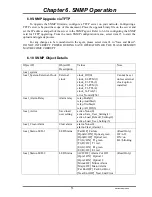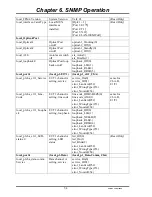
Chapter 4. Operation
39
Version 1.2 Apr 2006
For this example, choose the Internal Oscillator by pressing item "4".
LOCAL
<<< Define Port 3 Parameter >>>
Ch A Ch B Ch C Ch D
1. Service ON ON ON ON
2. Rate (Kbps) 2048 2048 2048 2048
3. Timing Int Osc Trans. Trans. Trans.
4. Loopback OFF OFF OFF OFF
5. CTS ON ON ON ON
Please select Function 1 ~ 5 or <ESC> to previous menu.
Note that the timing setting for channel "A" has changed to internal oscillator. If we <ESC>
back to the "Define System" menu we may also configure a card in port 4 by pressing "6".
Please
note the following
: The LAN bridge card has no settings which can be performed via the terminal
console. Please refer to the bridge card section for setting the DIP switch located physically on the
bridge card module.
4.5.7 Alarm Threshold Settings
Next we will escape back to the Define System menu and select item "7" for the Alarm
Threshold settings. Press "7" and the display will look like this:
LOCAL
<<< Define Alarm Threshold >>>
1. CV (Code Violation) [ 255 ]
2. ES (Error Seconds) [ 300 Sec. ]
3. SES (Severely Error Seconds)[ 300 Sec. ]
4. UAS (Unavailable Seconds) [ 300 Sec. ]
Please select the item or <ESC> to previous menu.
The current threshold settings are shown. The Code Violation, Error Seconds, Severely Error
Seconds and Unavailable Seconds thresholds may all be modified here. To modify a setting, choose
its item number. The available definitions for all are as follows:
CV: 255, 2048, or 65535 bits
ES: 300 sec., 600 sec., 900 sec.
SES: 300 sec., 600 sec., or 900 sec.
UAS: 300 sec., 600 sec., or 900 sec.






























